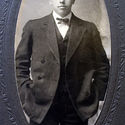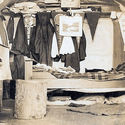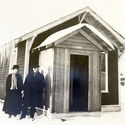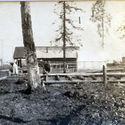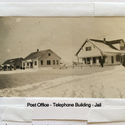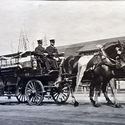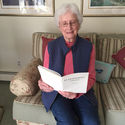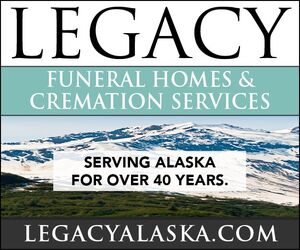Early Anchorage remembered
Family heirloom includes stories, snapshots
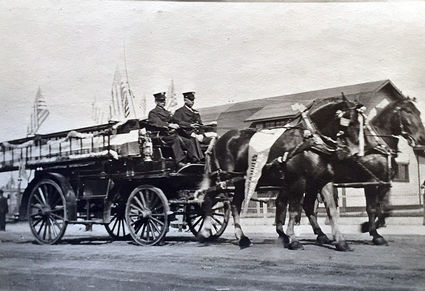
Courtesy Betty Berry
Frank Berry's early Anchorage photos include this one of the first fire department, located on F Street between Fourth and Fifth Avenues, and its fire engine, pulled by two horses. As city electrician, Berry wrote, "I was notified of every fire and was present at almost all of them to take care of electrical problems."
Betty Berry settles into a friend's living room couch early on a grey April morning and opens up a journal, "Elberberry Tales," stories told by her father-in-law, Frank Olin Berry. His words had been captured and written down in the 1950s by a family friend.
What Betty holds in her lap is a true treasure, a fascinating history of early Anchorage, its pages full of old black-and-white photos taken by her father-in-law, and stories previously kept within the Berry family.
Frank's tales begin almost a century ago, in 1916, a year after Anchorage was first settled as a burgeoning tent city, stretching along the shores of Ship Creek. Frank was 28, traveling from Spokane, Wash. He had temporarily left his wife of eight years, Lillie, behind, lured north to work on the construction of the railroad. His words are clear and full of good humor.
"Alaska beckoned to me," his journal begins. "I borrowed enough money to travel steerage on the Mariposa from Seattle to Anchorage. There were 30 of us in the steerage class, and several tons of hay, destined for the many horses then in use in construction of the railroad. As the hay took most of the room in the steerage section, we were given first class accommodations, except at meal times. This arrangement held until we reached Seward. There the hay was unloaded, and from Seward to Anchorage the first class passengers were denied the pleasure of our company.
"Dock facilities in Anchorage were inadequate for the Mariposa, so scows were sent out in the channel for debarking. If the tide happened to be out, the scows stopped and the passengers would slog on foot through the inlet mud to the shore.
"A partner of mine, already in Anchorage, owned a lot on 4th Avenue between B and C streets. We built a shack on it, and I went to work ... My first job in Anchorage was wiring the generator and switchboard at the power plant and installing the first central power station on Cook Inlet.
"It was cold that winter, working in the railroad yards. Walking up C Street hill after work, we noticed the air became warmer. Once reaching 4th Avenue, the temperature was 10 to 20 degrees warmer – thus we called it the Banana Belt.
"Our mainstay for energy during the cold winter months was syrup; we put it on everything, including steak, potatoes and bread. Our one-room cabin had a built-in bed, but no springs or mattress. We used blankets and woke up many mornings with frost on the inner walls of the cabin.
"In 1915 Anchorage was a tent city clustered around the railroad the government was building. The city was surveyed the same year, but by 1916 Anchorage had moved up the hill. It was a real town with wooden sidewalks, many stores and two theatres – the Empress and the Harmony. The movies changed three times a week, and the townspeople attended practically every time.
"There were four churches represented in 1916 – Presbyterian, Catholic, Episcopalian and Christian Science. A drama group was organized, and presentations were put on in the Empress Theatre.
"The population was about four or five thousand. We received mail once a week, as boats brought supplies to the railroad. Anchorage was a government town, and no liquor stores were allowed. Bootleggers did a brisk business. It was legal for citizens to order a barrel of beer and a case of whiskey twice a year for their own consumption. . . . Homemade whiskey was called White Mule and could be bought in stores – illegally. If the culprits were apprehended by the U.S. Marshall (the only law), they were sent to jail. While serving their sentence, they were put to work sawing up a never-diminishing pile of firewood kept behind the pokey.
"In 1917, I was earning 75 cents an hour, so sent for Lillie to join me. We bought a lot at 8th and E – way out from town – and lived in a tent until we built a small house. Our furniture was homemade or improvised from boxes. The Evergreen Memorial Chapel is now at our old location.
Anchorage in 1917
"By actual count, the population of the city was 5,209 in 1917," the book continues. "The Government Reserve accounted for another 347. The townsite of Anchorage was laid out by the U.S. Government, giving the north and south streets letters and the east and west streets numerals. . . . In 1917 there were about 80 phones in use in Anchorage.
"The fire department boasted one paid official and a volunteer crew. The fire engine was pulled by two horses. The fire house was located on the east side of F Street between 4th and 5th. J.J. Haffner was fire chief.
"The Anchorage General Hospital was at 536 K Street. Mrs. L.A. Burns was superintendent. The railroad maintained their own hospital at 3rd between A and B streets. [As of the 1950s, the building was still there. At that point, the most recent tenants were the Goodwill Industries.]
"The public schools recorded 206 pupils. Professor Sheets was principal, and Ora D. Clark was one of the teachers. [Clark Middle School was named for her.]
"Among the many businesses were harness manufacturers and horse shoers.
"The first dairy – the Anchorage Dairy – was located at 10th and L streets. At the time, it was way out of town ... When the first cow was brought to Anchorage, a small cabin was used as a barn. She was probably the only cow who could boast of lace curtains on her barn windows.
"Gramaphones were being sold at Eckmans located at 4th and K streets. Soft drinks for the family were offered by the Concord Grape Depot, who specialized in concord grapes, wild cherry and apple cider. The U.G. Crocker Store was selling tents, mattresses and bedding at 815 4th Avenue. Two bowling alleys kept the men in trim. It was not considered a ladies' sport, and bowling alleys were also pool halls that catered to men only.
"A.J. Wendler was president of the Chamber of Commerce, and Mrs. F. Mears was president of the Anchorage Women's Club, which met on call of the president and not once a month, as now.
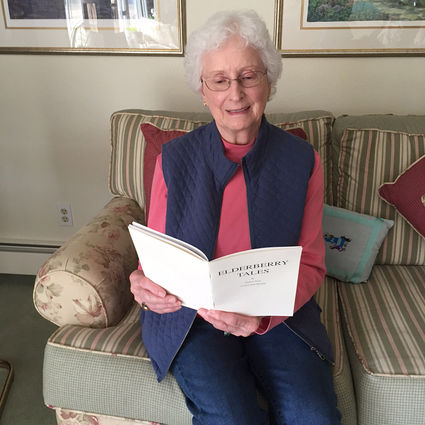
Dianne Barske photo
Betty Berry reads from her father-in-law's journal, "Elderberry Tales". The book's stories and photos have been kept in the family for years.
"There was one daily newspaper – The Anchorage Daily Times. E.L. Bedell was city editor. Three weekly papers were also published – Alaska Labor News, Alaska Railroad Record, and the Fortyninth Star.
"On K Street between 4th and 5th was the Electric Bath House where tub baths cost 50 cents, shampoos and facials were 50 cents, and rooms could be rented for $1. Ladies could get the latest fashions at Maud Cattles Style Shop in the Masonic Building."
Betty Berry looked up from her journal reading. "Elderbery Tales" goes on to list lots of other Anchorage businesses in 1917 along with mention of their proprietors, she said. Frank also told stories of the beginnings of Chickaloon Coal Mine and the clearing of the fire break, one block wide, from Cordova to P streets.
"We as a family can sense he delighted in telling these stories. We love the old photos he took, and are grateful to family friend, Ruth Marshall, for capturing his words and photos in the journal she compiled from hearing his tales."

